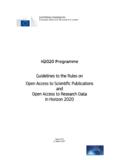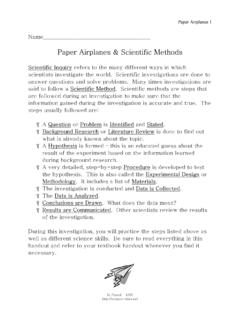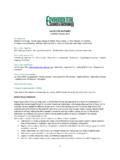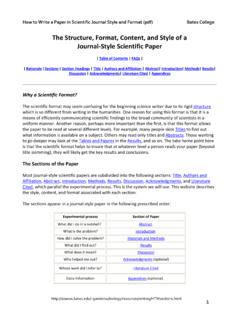Transcription of Scientific Discussion - European Medicines Agency
1 1/27 Scientific Discussion This module reflects the initial Scientific Discussion for the approval of Onsior (as published in December 2008). For information on changes after this date please refer to module 8 (Steps taken after authorisation). 1. INTRODUCTION The active substance of Onsior is robenacoxib, a non-steroidal anti-inflammatory drug (NSAID) of the coxib class which selectively inhibits the cyclooxygenase 2 enzyme (COX-2). The active substance, robenacoxib is a structural analogue to diclofenac. Onsior is available as tablets in five different strengths (6 mg for cats, and 5 mg, 10 mg, 20 mg and 40 mg for dogs) and as a solution for injection (20 mg/ml for dogs and cats). The benefits of Onsior are its efficacy in the treatment of pain and inflammation in dogs and cats. The most common side effects are gastrointestinal adverse events (vomiting, soft faeces) in cats and dogs; in dogs following long-term oral treatment, an increase in liver enzyme activities was noted.
2 The solution for injection might cause pain on injection. The approved indications are: Tablets Cats: Treatment of acute pain and inflammation associated with musculo-skeletal disorders at a once daily dose of 1 mg/kg body weight up up to six days. Dogs: Treatment of pain and inflammation associated with chronic osteoarthritis at a once daily dose of 1 mg/kg body weight as long as required (as directed by the veterinarian). Solution for injection: Cats: Treatment of pain and inflammation associated with soft tissue surgery. Dogs: Treatment of pain and inflammation associated with orthopaedic or soft tissue surgery in dogs. 2/27 2. QUALITY ASSESSMENT COMPOSITION The tablets are biconvex, round, beige to brown, imprinted on one side with the company logo NA and on the other side referring to the dosage strength (AK, BE, CD, BCK for dogs and AK for cats). Tablets of 6 mg robenacoxib are presented for cats, and tablets with a strength of 5, 10, 20, 40 mg ro-benacoxib for dogs.
3 Conventional pharmaceutical excipients for tablets are used and full details are included in the SPC. In order to facilitate palatability, tablets for cats contain yeast powder and tablets for dogs contain yeast powder and artificial beef flavour. The solution for injection for cats and dogs is a clear, colourless to slightly coloured (pink) liquid con-taining 20 mg/ml robenacoxib as active substance. Other substances are Macrogol 400, ethanol, anhy-drous Poloxamer 188, citric acid monohydrate, sodium metabisulphite, sodium hydroxide and water for injections. CONTAINER The tablets are packaged into aluminium / aluminium foil blisters, each containing 7 tablets. One cardboard box contains one, two, four (dogs only) or ten blisters. The solution for injection is presented in a 20 ml multidose amber glass vial, closed with a gray rubber stopper, sealed by an aluminium cap.
4 CLINICAL TRIAL FORMULAE All clinical trial formulae have been provided. Tablets for dogs which did not contain any flavour were initially developed and used in most of the pivotal pre-clinical and clinical trials. However, in order to increase the palatability of the tablets, yeast and artificial beef flavour were added. Pivotal studies conducted with the final formulation (con-taining yeast and artificial beef flavour) confirmed bioequivalence between the flavoured and non-flavoured formulations. The initially developed tablets for cats contained yeast and vanillin; however, vanillin was subse-quently removed because of incompatibility with the active substance. The final tablet formulation was used for most pivotal trials in cats. For the solution for injection, preliminary formulations are qualitatively identical to the final commer-cial formulation.
5 However, some studies were undertaken using a solution which differed quantita-tively with regard to active substance, macrogol 400 and ethanol. The preparations containing differ-ent amounts of ethanol were shown to be bioequivalent, in addition, an additional target animal safety trial was conducted with the final preparation. DEVELOPMENT PHARMACEUTICS Robenacoxib is a free acid. It is freely soluble in aqueous solution at alkaline pH values above 8, and in most organic solvents tested. At acidic pH values robenacoxib is practically insoluble in aqueous solution; solubility in pure water is poor. In acid solutions the active substance readily degrades to form a lactam. Robenacoxib exists in different polymorphic forms. The more stable form at room temperature was chosen and was shown to be chemically and physically stable under registration sta-bility conditions.
6 The excipients used for the tablets are standard substances in tablet formulations for use in dogs and cats. In both, tablets for dogs and cats, yeast, microcrystalline cellulose, crospovidone, povidone, an-hydrous colloidal silica and magnesium stearate are used. The tablets for dogs also contain powdered cellulose and artificial beef flavour as a flavour. The excipients selected for the solution for injection are well accepted for use in injection formulations and are standard ingredients and their choice was based on the properties of the active substance. In the solution for injection, water for injection is used as solvent, macrogol 400 and ethanol as co-3/27 solvent, poloxamer 188 as solubiliser, citric acid monohydrate and sodium hydroxide for pH control, and sodium metabisulphite as antioxidant. Compatability of the various excipients was established. CONTAINER Because of absorptive properties of the yeast and in order to avoid water uptake, a non moisture-permeable (Al/Al) blister was selected.
7 The suitability of the primary packaging was shown in the sta-bility studies. No incompatibility of the formulation with the primary packaging material in contact with the product was noticed. The solution for injection is presented in a 20 ml amber Type I glass vial, with a closure comprising a chlorobutyl stopper with aluminium crimp seal. The use of amber coloured vials to prevent photo-instability of the finished product is justified, since solutions of robenacoxib in various solvents proved to be very sensitive to light resulting in an increase of degradation products. FORMULATION DEVELOPMENT Tablets The development of the tablet formulations took place in two steps. During the initial development phase, the formula was modified several times to adapt tablet size and dosage strength to the final dos-age regime and marketing requirements.
8 Initially the tablet weight was identical (160 mg) for all dos-age strengths. However, in order to visually differentiate the tablets appearance according to their re-spective strengths, different weights per strength were introduced the tablet weights for the 5 mg, 10 mg, 20 mg and 40 mg dosage strengths are respectively 80 mg, 160 mg, 320 mg and 640 mg. All tablets contain the same concentrations of active substance ( ) and of excipients. Initial formulations contained lactose; however, in order to enhance the palatability, this ingredient was later replaced by yeast (dog, cat) and artificial beef flavour (dogs only). Since yeast is not suitable for a direct dry compression process, a wet granulation step was introduced. The preparation of a granulate common for both dog and cat tablets was developed. In the granulate yeast acts as a water management system and favourably interacts with the equilibrium between ro-benacoxib and its lactam degradant.
9 Artificial beef flavour is only contained in the dog formulation and therefore only added in the extragranular phase. Since robenacoxib is practically insoluble in wa-ter, a phosphate buffer pH is used to ensure sufficient dissolution of the active substance in the medium at that pH. The dissolution test parameters have been selected according to procedure to ensure sink con-ditions. Tablets for dogs dissolve faster than the tablet for cats due to the presence of artificial beef flavour in dog tablets which acts as a hygroscopic agent and allows a faster disintegration. Dissolution was not significantly affected by formulation, dosage strength or size of the tablets. Solution for injection As robenacoxib is poorly soluble in water, co-solvents such as macrogol 400 and ethanol were added, and poloxamer 188 was selected as a potential solubiliser for the active substance.
10 During stability studies at 40 C for three months the preliminary solution for injection containing robenacoxib discoloured to a pink colour whilst there was no significant deterioration of the ac-tive substance due to oxidation. Therefore, sodium metabisulphite was added as an antioxidant. The solution for injection was initially developed with a lower 1% (w/v) concentration; however, for clinical reasons the concentration was subsequently increased to a 2% (w/v) or 20 mg/ml of robena-coxib. When increasing the concentration of the active substance, it was found that the same vehicle can be used; however, to reach the desired pH more base was added, and the concentrations of sodium metabisulphite and macrogol 400 increased. No antimicrobial preservative is added to this injectable multidose preparation as the product has adequate inherent antimicrobial activity on the grounds of the 4/27 significant non-aqueous solvent loading.













